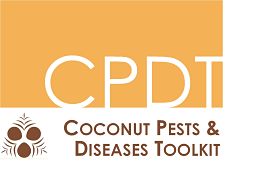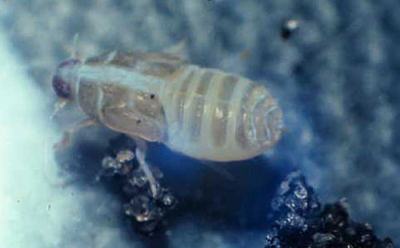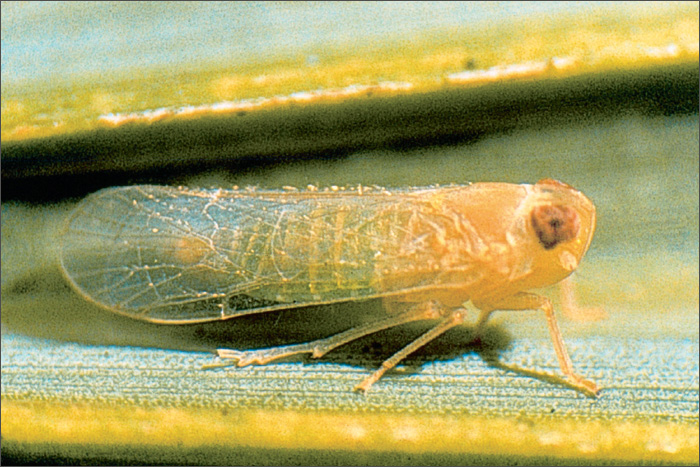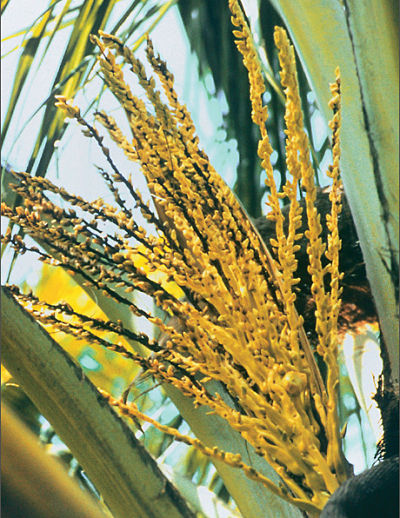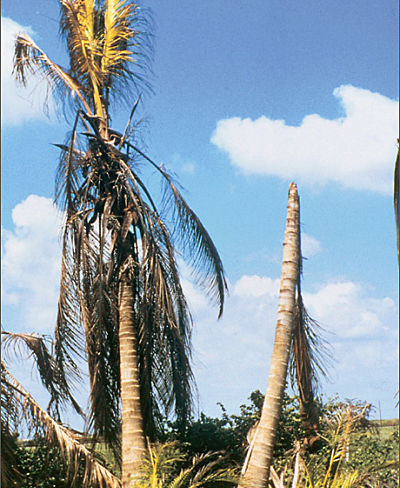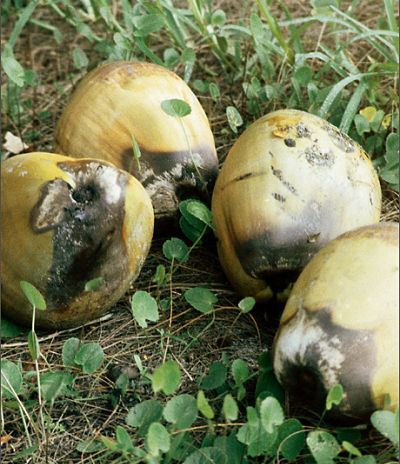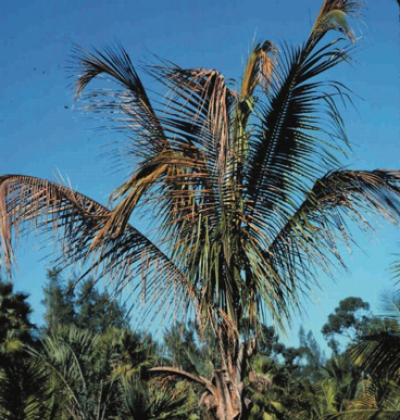Lethal yellowing
Lethal yellowing of coconut palms is caused by several different, but related phytoplasma bacteria in different places around the world. These are HIGH risk diseases of coconut palms, however the diseases are not found in the Pacific, with the exception of Bogia coconut syndrome (BCS).
The most serious lethal yellowing is caused by Phytoplasma palmae, which is spread by the American palm cixiid (Haplaxius crudus (formerly Myndus crudus), originally from South America. However different causes of lethal yellowing occur around the world. The information provided on this page (particularly around controlling the disease) is related to where the disease is currently found, and is provided as reference. The key take-home message is that biosecurity is critical to prevent the spread of lethal yellowing diseases to the Pacific.
Common name of the diseaseLethal yellowing |
Scientific name of the cause of the diseasePhytoplasma palmae and other species |
on this page: Vector insects : Symptoms : Impacts : Distribution : Prevention : Controlling lethal yellowing : Information sources and further reading
Phytoplasmas are highly specialised wall-less bacteria that can survive only inside the plants that host them and the insects that spread them from plant to plant. They cannot be cultured and can only be studied using the tools of molecular biology. Because of this they have complex grouping and naming conventions.
The lethal yellowing phytoplasma in the Caribbean and Central America, including Florida, was the first to be found and belongs to a group of phytoplasmas labelled 16SrIV. There is significant variation, depending on location in the region. In East Africa (Kenya and Tanzania), a phytoplasma also in the 16SrIV group is causing great devastation. Other phytoplasmas causing similar disease elsewhere in Africa (Nigeria, Togo, Cameroon, Mozambique, Ghana and Cote d’Ivoire) are placed in the 16SrXXII group. 16SrXXII is likely to be the group that a new phytoplasma recently discovered in PNG, and given the name 'Candidatus Phytoplasma noviguineense', will be placed in.
Less severe phytoplasma diseases of coconuts, that show different, milder symptoms, also occur closer to the Pacific Islands, in Malaysia, Sri Lanka and Indonesia.
This youtube video discusses advanced diagnostics for lethal yellowing disease.
Vector insects
Phytoplasmas are very small bacteria found in the food conducting vessels (phloem) of host plants. The bacteria are spread from plant to plant by sap-feeding insects. To do this they must reproduce inside the insect’s bodies and usually this is only possible for a small number of insect species. These are known as vector insects.
The American palm cixiid, Haplaxius crudus (formerly Myndus crudus) is a planthopper insect. Haplaxius crudus is the only insect proven to be a vector of ‘Candidatus Phytoplasma palmae’ in controlled experiments . However, other vectors have also been suggested but not confirmed.
This American palm cixiid is present only in the Americas. However, it is certain that other vectors exist in other regions of the world and possibly also in the Americas. Recent research in Papua New Guinea suggests at least four families of insects transmit a similar phytoplasma there. This suggests that there is likely to be many potential vector insects already present in the Pacific Islands.
EggsEggs are tiny - around 0.5-0.6 mm long by 0.15–0.20 mm wide. They are white and spindle-shaped (a long oval) with one 'blunt' end. The eggs can be seen about 1-2 cm away from the soil on grasses in rows of up to five eggs or singularly. NymphsNymphs are the young cixiid that look similar to adults but have stumped wings that are yet to develop. They are a tan to grey colour with a blush red head. Nymph eyes remain a dark maroon colour. They undergo 5 growth stages (instars) starting at around 0.7 mm in length and growing to around 3 mm at the 5th instar. The nymphs are found on roots of grasses where female adults originally laid eggs. They can be seen at the surface of soil or up to 3 cm deep, covered by leaf or organic material. AdultsHaplaxius crudus adults are a creamy white coloured cixiid (a type of planthopper) with green abdomens. Male abdomens are a brighter green. The adults are around 4-5 mm long, not including their pair of antennae. Females are generally longer than males. The adults feed and mate on palm fronds and are active at day and night. During the day, adults eyes are white and at night they are maroon coloured (changing with light). |
Nymph with stumped wings (© Jim DeFilippis, University of Florida)
Female Haplaxius crudus with changing maroon coloured eyes (© Nigel A. Harrison, University of Florida) |
Symptoms
Lethal yellowing disease infects coconuts in phases.
Firstly, all the nuts, whether ripe or not will often drop. This does not always occur.
Next the inflorescences (flower clusters) will blacken as they rot.
Obvious yellowing of leaves then occurs from the bottom of the crown up.
Fronds die and hang down. This is followed by necrosis (death) of pinnae (the individual parts of the spear leaf) of the emerging spear leaf. This necrosis then spreads to the growing point
Death of the growing point of the palm occurs next.
The crown falls, leaving a dead trunk only, sticking up like a telegraph pole.
|
Blackening of the inflorescences (flower clusters) starting at the spike tips and male flowers (© Nigel A. Harrison, University of Florida) |
Coconut palm with yellow fronds at the top and dead brown fronds hanging down (Left) and deal palm without any crown (Right) (© Nigel A. Harrison, University of Florida) |
|
|
Nuts that have fallen before maturing with brown-black rot at the calyx-end (© Nigel A. Harrison, University of Florida) |
Malayan Dwarf variety with red-greyish brown leaves (© Nigel A. Harrison, University of Florida) |
Each of these symptoms can be caused by other pests or diseases, or by stress factors such as poor growing conditions. The key difference is the sequence of symptom development, and its rapid speed, which is unique to phytoplasma disease.
Another important feature is the obvious aggregation (grouping) or patchiness of diseased palms, due to plant to plant spread, with patches expanding rapidly.
This is quite different to stress factors from poor growing conditions which are more uniform in their presentation. For example, all plants in the area will be affected by poor soils.
Impacts
Lethal yellowing diseases can have serious impacts on coconut production where they are present.
Highly susceptible varieties such as the Atlantic tall/Jamaica tall are widespread within the Caribbean region and Atlantic coast of the Americas.
Florida has lost around 50% of their estimated one million coconut palms, and Jamaica has lost around 80% of their five million coconut palms due to lethal yellowing over the past three decades. The Atlantic coasts of southern Mexico and Honduras are experiencing similar losses.
West African countries have reported over 350 hectares of plantations being destroyed in an outbreak. Around 12,000 tonnes of copra have been lost per year and 7000 hectares threatened.
Replanting of susceptible coconut varieties in lethal yellowing affected places such as Florida and Jamaica is now restricted. However, coconut palms take years to become fruit-bearing. If this is too long for people to wait, plantations may be abandoned, relocated or planted with other crops, incurring economic losses.
These economic losses and restrictions on planting greatly reduce production of coconut materials and therefore profit. Improvements in coconut production have greatly benefited countries socially and economically. To lose so many palms to lethal yellowing with the inability to find resistant varieties is likely to create poverty and put the livelihood of many people in jeopardy.
Distribution
Papua New Guinea's Bogia coconut syndrome is a suspected lethal yellowing disease, the first account in the Pacific.
Lethal yellowing diseases are presently most active in the Caribbean including Antigua and Barbuda, Belize, Benin, Cameroon, Cayman Islands, Cuba, Dominican Republic, Florida (USA), Ghana, Guatemala, Haiti, Honduras, Jamaica, Kenya, Mexico, Mozambique, Nigeria, Tanzania, Togo, Netherlands Antilles, Saint Kitts and Nevis.
Please check with your local biosecurity / quarantine or SPC for up-to-date distribution information.
Prevention
Most importantly, the International Guidelines for transfer of coconut germplasm should be strictly followed to prevent pests and diseases being moved to new locations.
Although quarantine restrictions are in place for the movement of live coconut tissue, requirements vary by country. Check with your biosecurity / quarantine staff.
Many species of palm are affected. Coconuts in close proximity to other palm species that are infected are susceptible to the vector insect, and therefore the disease.
The patterns in the spread of the disease have been variable, which makes control difficult. One or two palms in an area may initially show symptoms, and then symptoms appear randomly in other palms within the site. In other cases the disease has apparently jumped from 2 - 100 km or more creating new local infection patterns.
Visual inspections for symptoms will not be sufficient to determine the stage of disease, due to the symptomless incubation phase. Detection is difficult as no diagnostic tests have been developed. Ribosomal RNA analysis is the quickest testing method. However, it relies on detectable levels of the pathogen which is low at the initial phase of the disease and may not present until 47 - 57 days before yellowing of the leaves.
Lethal yellowing symptoms can be easily misdiagnosed. If one symptom is observed but not another it may be interpreted as another disease or nutrient deficiency.
For general information on preventing pests and diseases of coconut, see the Prevention section.
Conventional and real time molecular testing (PCR) can be done in specialist laboratories to confirm the presence and identity of phytoplasmas in palms. This process needs good quality DNA. The highest concentrations of DNA can be obtained from immature inflorescence and heart tissue. It is therefore best to sample the apical bud (the heart of the palm) or the healthy inflorescence tissue closest to the rotting tissue.
Sampling the heart of a mature palm is difficult, time consuming and of course, kills the palm. An alternative non destructive technique, especially useful when a phytoplasma is just a suspicion, is to use a drill to sample internal trunk tissue. The way to do this is described by the Fort Lauderdale Research and Education Center [ONLINE]. Contact SPC for further information on testing.
Controlling lethal yellowing
We strongly recommend an integrated pest management (IPM) approach to the control of all insects, where possible. This is a combination of methods (pesticides, physical controls such as site hygiene, and biological controls) to minimise the use of pesticides and minimise the cost of control.
Integrated Pest Management
The goal of IPM is to keep pest populations to a level below which that are doing harm. IPM involves using multiple control options together for the economic control of pests (i.e. cultural, natural and chemical). In an agricultural context the Food and Agriculture Organization defines IPM as "the careful consideration of all available pest control techniques and subsequent integration of appropriate measures that discourage the development of pest populations and keep pesticides and other interventions to levels that are economically justified and reduce or minimize risks to human health and the environment. IPM emphasizes the growth of a healthy crop with the least possible disruption to agro-ecosystems and encourages natural pest control mechanisms".
Integrated Pest Management of lethal yellowing in the Caribbean
The information below is based on experiences in controlling lethal yellowing in the Caribbean. If lethal yellowing does arrive in the Pacific, this information will need to be validated for usefulness here.
Currently, the most successful integrated pest management used to reduce the incidence of lethal yellowing disease was created by Michael Black, a palm grower in Jamaica. The methods used include removing palms with lethal yellowing symptoms immediately by cutting them down and burning. Replanting is done with varieties that are considered resistant and produce high yields. Weed control and a good fertilization regime is implemented on the whole plantation and includes strict weekly surveillance and quarantine.
Many methods can be uneconomical and difficult, especially if vectors are uncertain.
Cultural
Phytoplasmas are known to be spread through the movement of plant material. The movement of live palm tissues from infected to non-infected areas is not permitted to reduce further spread. When movement does occur, the FAO/IBPGR Technical Guidelines for the Safe Movement of Coconut Germplasm must be followed.
Planting resistant varieties such as Chowghat green dwarf, Cuban dwarf, Fiji dwarf, Red spicata dwarf, Sri Lanka yellow dwarf and King has proven to be a potential way of reducing the spread of lethal yellow diseases. However, in some cases, trees can be infected even through commercial growers do not admit to this. It is important to have palms tested for disease rather than simply accept they are free of disease.
Clear and remove host plants of the Haplaxius crudus nymphs. These include St. Augustine or buffalo grass (Stenotaphrum secundatum) and Guinea or Panic grass (Megathyrsus maximus).
Natural
Vectors such as Haplaxius crudus are regarded as the main mode of spread. Planting species that are considered poor breeding hosts of these vectors have been beneficial. These include ground covers; tropical forage grasses such as Brachiara brizantha, Chloris gayana or Hemarthria altissima. Palm species that underly coconut palms and are resistant to vectors have also been useful. Legumes are currently being investigated such as Tropical-kudzu (Pueraria phaseoloides) and Perennial peanut (Arachis pintoi). Non-host plants should be shade tolerant. We caution against introducing plants if these are not found in the area, as this can also cause problems.
Vector trapping with species-specific pheromones has been suggested for monitoring a mass trappings. However pheromones have not yet been developed.
Chemical
The rate of spread has been reduced by the use of insecticides for vectors such as Haplaxius crudus. However, these are not generally recommended as they need to be applied for the duration of the palm's life, making it highly expensive and harmful to the natural environment.
The systemic application of injecting Oxytetracycline-HCl (a Terramycin antibiotic) into the palm can be effective in controlling the spread and prevent infection of the disease on palms used for landscaping and feature plants. However, this is uneconomical for large-scale plantations and nurseries. For application methods and costs, see the disease management section of this web page.
Cutting down and burning diseased palms has proven to be better economically and environmentally than the use of chemicals.
Information sources and further reading
CABI. 2018. Candidatus Phytoplasma palmae (lethal yellowing of coconut). [ONLINE]
Gurr et al. 2016. Coconut lethal yellowing diseases: a phytoplasma threat to palms of global economic and social significance. Frontiers in plant science, 7, pp. 1-21.
Harrison and Elliott. Lethal Yellowing (LY) of Palm. University of Florida, pp. 1-7.
Harrison and Elliott (The American Phytopathological Society). 2008. Lethal Yellowing of Palms. [ONLINE]
Howard. 2015. Featured creatures: American palm cixiid (Myndus crudus Van Duzee) [ONLINE]
Idtools. 2013. American palm cixiid. [ONLINE]
Molet, T. 2013. CPHST Pest Datasheet for Haplaxius crudus. [ONLINE].
content reviewed by Richard Davis, Northern Australia Quarantine Strategy, Department of Agriculture and Water Resources, July 2018
